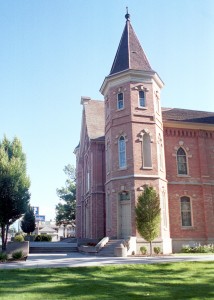The Provo Tabernacle stood as a city landmark for more than 100 years — a testament to the town’s pioneer settlers and to the culture of worship that defines its residents. The history and grandeur of the building set a standard for downtown Provo and welcomed both religious and community gatherings inside its dedicated walls. That’s until it was destroyed by a devastating fire in December 2010.
For nearly 10 months the building sat in ashes waiting for The Church of Jesus Christ of Latter-day Saints to announce its fate. On Oct. 2, President Thomas S. Monson announced the fire-torn building would not only be preserved, but would be resurrected into the most revered of LDS buildings, a temple of God.

“I was entirely thrilled to hear the building would be turned into a temple,” said Mark Graham, who is serving as a bishop in the Provo Student Married Second Stake. “I think this will make both preservationists and Church members happy to have the building restored and rebuilt into a house of worship.”
The Provo Tabernacle is not the first building the Church has modified into a temple. The Manhattan, Denmark and Vernal temples were all built on existing structures.
“We had to go in and demolish everything inside except the outside walls,” said Bill Naylor about the construction of the Vernal Temple, which was built in the shell of an existing tabernacle.
Naylor served as the assistant project manager and inspector of the Vernal Temple construction. He said the transformation of the Vernal Tabernacle into a temple was more difficult and expensive than if the Church had chosen to start from scratch.
“Rebuilding or remodeling like that is quite expensive,” Naylor said. “It is more expensive to reinforce everything to get it to standard. Remodeling these old pioneer buildings creates other difficulties. The foundations were made from rock and you have to reinforce and underpin the footings underneath.”
The Provo Tabernacle faces a similar challenge to the construction of the Vernal Temple. The foundation has to be strengthened and the building reinforced before construction can continue. Additionally, the temple will face an estimated 25 to 40 percent more time for basic structure construction since detail will be taken to preserve the history of the building.
“I’m very pleased the Church has decided to restore [it],” said Eph Hatch, a retired building designer for BYU and Provo historian. “When you realize how the people had to struggle to build it compared to how easy it is now . . . We should preserve the era that has passed. Provo’s history needs to be preserved and there is no better way than by restoring the tabernacle into a temple.”
In his conference address to the Church, President Monson announced the temple would be rebuilt with full preservation and restoration to the exterior of the existing tabernacle. Naylor said President Gordon B. Hinckley was emphatic that the Vernal Temple should be restored properly and that the outside walls appear as they did when first built. Although designers added a new entrance to the building, they preserved the Vernal Tabernacle’s structure.
Church officials said they plan to add a steeple to the center of the temple roof to reflect the original tabernacle. When it was first built the tabernacle had a large steeple, but it was removed in 1917 because of the sagging roof structure.
“The task of dismantling the tower, which extended 147 feet from the ground, undoubtedly was as challenging as its construction in the first place,” said N. LaVerl Christensen in his book “Provo’s Two Tabernacles.”
The tower removal cost $6,030 and the 500-pound bell that rang in the tower was moved. The bell now hangs as the Victory Bell just south of the Marriott Center.
Although the Church has not released architectural plans or given an estimated time of completion, the project is expected to be extensive and difficult.
“It is really a wonderful thing to work on a historical building,” Naylor said. “Although it is difficult and tedious, it is a wonderful thing to see it as a completed project.”




